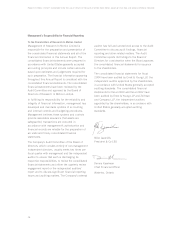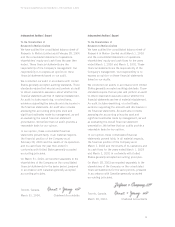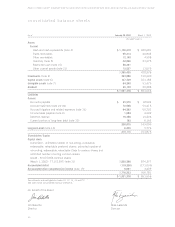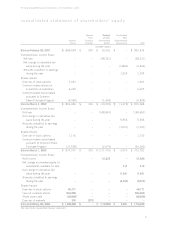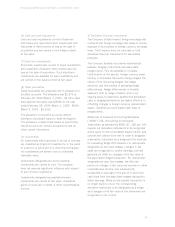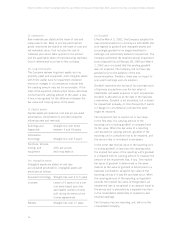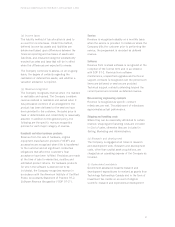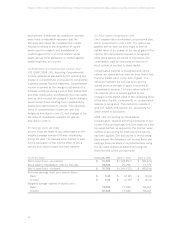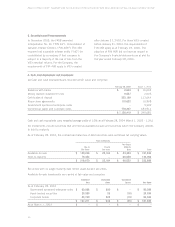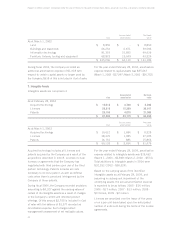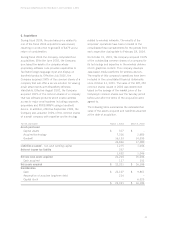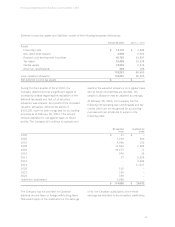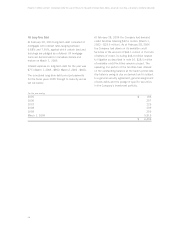Blackberry 2004 Annual Report Download - page 38
Download and view the complete annual report
Please find page 38 of the 2004 Blackberry annual report below. You can navigate through the pages in the report by either clicking on the pages listed below, or by using the keyword search tool below to find specific information within the annual report.
36
Research In Motion Limited • Incorporated Under the Laws of Ontario (In thousands of United States dollars, except per share data, and except as otherwise indicated)
(j) Inventories
Raw materials are stated at the lower of cost and
replacement cost. Work in process and finished
goods inventories are stated at the lower of cost and
net realizable value. Cost includes the cost of
materials plus direct labor applied to the product
and the applicable share of manufacturing overhead.
Cost is determined on a first-in-first-out basis.
(k) Long-lived assets
The Company reviews long-lived assets such as
property, plant and equipment, and intangible assets
with finite useful lives for impairment whenever
events or changes in circumstances indicate that
the carrying amount may not be recoverable. If the
total of the expected undiscounted future cash flows
is less than the carrying amount of the asset, a loss,
if any, is recognized for the difference between the
fair value and carrying value of the asset.
(l) Capital assets
Capital assets are stated at cost less accumulated
amortization. Amortization is provided using the
following rates and methods:
Buildings and Straight-line over terms
leaseholds between 5 and 40 years
Information
technology Straight-line over 5 years
Furniture, fixtures,
tooling, and 20% per annum
equipment declining balance
(m) Intangible assets
Intangible assets are stated at cost less
accumulated amortization. Intangible assets are
amortized as follows:
Acquired technology Straight-line over 2 to 5 years
Licenses Lesser of 5 years or on a per
unit basis based upon the
anticipated number of units
sold during the terms of the
license agreements
Patents Straight-line over 17 years
(n) Goodwill
Effective March 3, 2002, the Company adopted the
new recommendations in accordance with SFAS 142
with regards to goodwill and intangible assets and
accordingly, goodwill is no longer amortized to
earnings, but periodically tested for impairment. The
Company performed the required annual impairment
tests of goodwill as at February 28, 2004 and March
1, 2003 and concluded that the existing goodwill
was not impaired. The Company did not have any
goodwill prior to the adoption of the new
recommendation, therefore, there was no impact to
prior year’s earnings upon its adoption.
Goodwill represents the excess of the purchase price
of business acquisitions over the fair value of
identifiable net assets acquired in such acquisitions.
Goodwill is allocated as at the date of the business
combination. Goodwill is not amortized, but is tested
for impairment annually, or more frequently if events
or changes in circumstances indicate the asset
might be impaired.
The impairment test is carried out in two steps.
In the first step, the carrying amount of the
reporting unit including goodwill is compared with
its fair value. When the fair value of a reporting
unit exceeds its carrying amount, goodwill of the
reporting unit is considered not to be impaired, and
the second step is considered unnecessary.
In the event that the fair value of the reporting unit,
including goodwill, is less than the carrying value,
the implied fair value of the reporting unit’s goodwill
is compared with its carrying amount to measure the
amount of the impairment loss, if any. The implied
fair value of goodwill is determined in the same
manner as the value of goodwill is determined in a
business combination using the fair value of the
reporting unit as if it was the purchase price. When
the carrying amount of the reporting unit goodwill
exceeds the implied fair value of the goodwill, an
impairment loss is recognized in an amount equal to
the excess and is presented as a separate line item
in the consolidated statements of operations and
retained earnings.
The Company has one reporting unit, which is the
consolidated Company.




